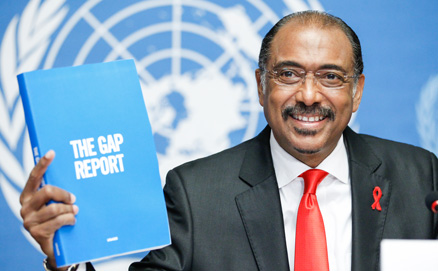
In what the Joint United Nations Programme on HIV/AIDS (UNAIDS) declares as “the first report of its kind,” The Gap Report argues that the global HIV/AIDS epidemic may be brought under control by 2030. Published on July 10, 2014, it states that global HIV infection and AIDS-related deaths have steadily decreased over the past decade. The report identifies a series of gaps (knowledge, treatment, funding) that hinder the potential to end the epidemic while offering steps to reach a viable 2030 goal.
The news broke ahead of the 2014 International AIDS Conference, held on July 20-25th in Melbourne, Australia. This year’s theme, entitled Stepping up the Pace, aimed at “captur[ing] the optimism that has recently emerged and build on it to ensure that HIV remains on top of the global agenda.” Delegates discussed six main objectives: engage governments, communities and stakeholders; break down barriers including stigma, discrimination and repressive policies; address structural political challenges; surge efforts within key populations and regions; increase funding and collaboration; and reaffirm the place HIV/AIDS combat within international development.
The global statistics appear promising. Since the outbreak of the epidemic, HIV/AIDS has affected 78 million people worldwide, 40 million of whom have died. Today, approximately 35 million people live with HIV. The total rate of new HIV infections has dropped by 38% since 2001. In 2005, 2.4 million people died from AIDS-related causes, the highest rate of any year. That number has since fallen by 35%.

The report breaks down regional statistics based on the 2005 peak. While new infections have marginally risen in Europe, North America, Central Asia and the Middle East (5-8%), many regions have experienced a marked decline. The rate of infection in Latin American, East Asia and the Caribbean fell by 3, 6, and 39% in addition to the death rate falling by 27, 31 and 50%, respectively. In sub-Saharan Africa, which contains 70% of all HIV-positive people, new infections fell by 33% and deaths by 39%. Furthermore, nearly 90% of those tested positive in sub-Saharan Africa have access to antiretroviral medication.
Although the statistics are encouraging, many issues continue to impinge on greater success. The current funding rate for HIV/AIDS sits at 19 billion USD, with half of all spending directed to low and middle income countries. UNAIDS estimates that funding will need to increase to 22-24 billion USD by 2015. Furthermore, merely 37% of infected people have undergone antiretroviral drugs therapy. For children living with the disease, this number is as low as 24%. Most alarmingly, 19 million people remain unaware of their HIV-positive status.
The report offers a number of specific policy suggestions, but ends with an eight point action plan. The authors suggest decentralizing HIV service delivery, collaborating with existing health programmes, and zeroing-in on target regions, populations and communities. They also propose expanding prevention and treatment options, increasing leadership and investment, framing disease-control as a shared project, and, finally, vigorously working towards a vaccine and/or cure.
UNAIDS Executive Director, Michel Sibibé, offers ominous words amidst the enthusiasm, stating that “[w]e have a fragile five year window of opportunity because what we do over the next five years will determine the next fifteen.” Indeed, harnessing the current momentum will be critical.




